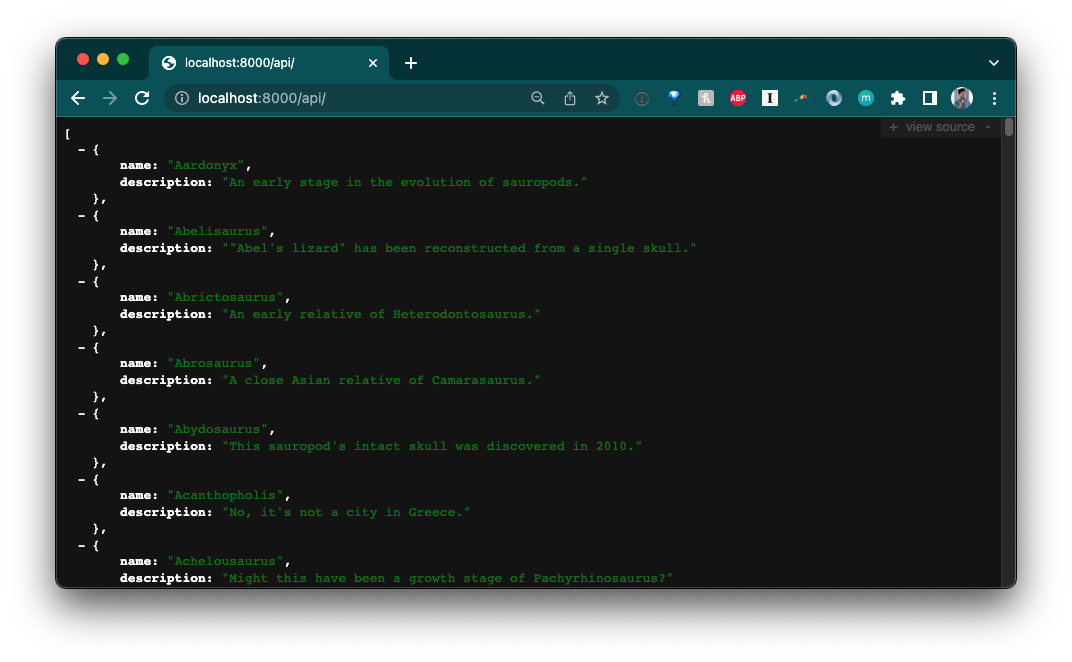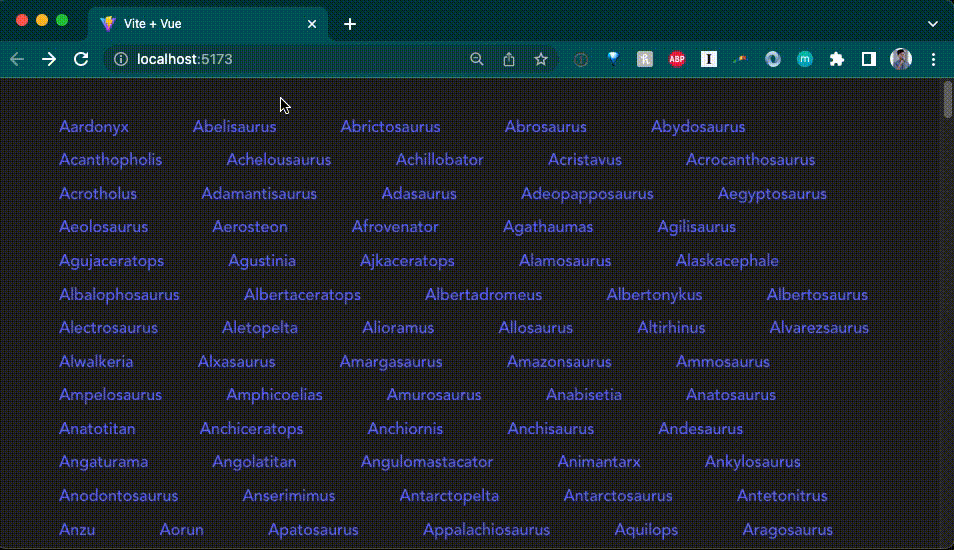Vue is a progressive front-end JavaScript framework, built for performance and versatility.
This How To guide will show you how to create a simple app using Deno, Vite, and Vue.
We'll use Vite to scaffold our Vue app. First, run:
deno run -A npm:create-vite-extra
Name your project, then select "deno-vue".
Then, cd into your new project and run:
deno task dev
You should now be able to view your default Deno and Vue app in your browser:
The next step is to add a backend API. We'll create a very simple API that returns information about dinosaurs.
In the directory, let's create an api folder. In that folder, we'll create a
main.ts file, which will run the server, and a data.json, which is the hard
coded data.
mkdir api && touch api/data.json && touch api/main.ts
Copy and paste
this json file
into your api/data.json.
Then, let's update api/main.ts:
import { Application, Router } from "https://deno.land/x/[email protected]/mod.ts";
import { oakCors } from "https://deno.land/x/[email protected]/mod.ts";
import data from "./data.json" with { type: "json" };
const router = new Router();
router
.get("/", (context) => {
context.response.body = "Welcome to dinosaur API!";
})
.get("/api", (context) => {
context.response.body = data;
})
.get("/api/:dinosaur", (context) => {
if (context?.params?.dinosaur) {
const filtered = data.filter((item) =>
item["name"].toLowerCase() === context.params.dinosaur.toLowerCase()
);
if (filtered.length === 0) {
context.response.body = "No dinosaurs found.";
} else {
context.response.body = filtered[0];
}
}
});
const app = new Application();
app.use(oakCors()); // Enable CORS for All Routes
app.use(router.routes());
app.use(router.allowedMethods());
await app.listen({ port: 8000 });This is a very simple API server using oak that
will return dinosaur information based on the route. Let's start the API server:
deno run --allow-env --allow-net api/main.ts
If we go to localhost:8000/api, we see:
Lookin' good so far.
Let's update src/components. We'll add the files:
HomePage.vue, the component for the home pageDinosaurs.vue, the component that lists all dinosaur names as anchor links, andDinosaur.vue, the component that shows an individual dinosaur's name and description
touch src/components/HomePage.vue src/components/Dinosaurs.vue src/components/Dinosaur.vue
Before we create the components, let's add some state management.
In order to maintain state across our <Dinosaur> and <Dinosaurs> components,
we'll use Vue store.
Note: for more complex state management, check out the Vue-endorsed Pinia library.
Create a src/store.js file:
touch src/store.js
And in it, let's add:
import { reactive } from "vue";
export const store = reactive({
dinosaur: {},
setDinosaur(name, description) {
this.dinosaur.name = name;
this.dinosaur.description = description;
},
});We'll import store into both Dinosaurs.vue and Dinosaur.vue to set and
retrieve dinosaur name and description.
In Dinosaurs.vue, we'll three things:
- send a
GETrequest to our API and return that asdinosaurs - iterate through
dinosaursand render eachdinosaurin<router-link>that points to the<Dinosaur>component - add
store.setDinosaur()to@clickon eachdinosaur, which will set thestore
Here is the complete code below:
<script>
import { ref } from 'vue'
import { store } from '../store.js'
export default ({
async setup() {
const res = await fetch("http://localhost:8000/api")
const dinosaurs = await res.json();
return {
dinosaurs
}
},
data() {
return {
store
}
}
})
</script>
<template>
<div class="container">
<div v-for="dinosaur in dinosaurs" class="dinosaur-wrapper">
<span class="dinosaur">
<router-link :to="{ name: 'Dinosaur', params: { dinosaur: `${dinosaur.name.toLowerCase()}` }}">
<span @click="store.setDinosaur(dinosaur.name, dinosaur.description)">
{{dinosaur.name}}
</span>
</router-link>
</span>
</div>
</div>
</template>
<style scoped>
.dinosaur {
}
.dinosaur-wrapper {
display: inline-block;
margin: 0.15rem 1rem;
padding: 0.15rem 1rem;
}
.container {
text-align: left;
}
</style>In Dinosaur.vue, we'll add:
- importing
store - rendering
store.dinosaurin the HTML
<script>
import { store } from '../store.js';
export default {
data() {
return {
store
}
}
}
</script>
<template>
Name: {{ store.dinosaur.name }}
<br />
Description: {{ store.dinosaur.description }}
</template>Next, we'll update HomePage.vue. Since the Dinosaurs component needs to
fetch the data from the API, we'll use
<Suspense>, which manages
async dependencies in a component tree.
<script>
import { ref } from 'vue'
import Dinosaurs from './Dinosaurs.vue'
export default {
components: {
Dinosaurs
}
}
</script>
<template>
<Suspense>
<template #default>
<Dinosaurs />
</template>
<template #fallback>
<div>Loading...</div>
</template>
</Suspense>
<p>
Check out
<a href="https://vuejs.org/guide/quick-start.html#local" target="_blank"
>create-vue</a
>, the official Vue + Vite starter
</p>
<p class="read-the-docs">Learn more about using Deno and Vite.</p>
</template>
<style scoped>
.read-the-docs {
color: #888;
}
</style>Tying it all together, let's update src/App.vue:
<script setup>
</script>
<template>
<router-view/>
</template>
<style scoped>
</style>You'll notice that we have used <router-link> and <router-view>. These
components are part of the vue-router library,
which we'll have to setup and configure in another file.
First, let's import vue-router in our vite.config.mjs file:
import { defineConfig } from "npm:vite@^3.1.3";
import vue from "npm:@vitejs/plugin-vue@^3.2.39";
import "npm:vue@^3.2.39";
import "npm:vue-router@4";
// https://vitejs.dev/config/
export default defineConfig({
plugins: [vue()],
});Next, let's create a folder named router. In it, let's create index.ts:
mkdir router && touch router/index.ts
In router/index.ts, we'll create router, which contains information about
each route and their component, and export it. For more information on using
vue-router, check out their guide.
import { createRouter, createWebHistory } from "vue-router";
import HomePage from "../components/HomePage.vue";
import Dinosaur from "../components/Dinosaur.vue";
const routes = [
{
path: "/",
name: "Home",
component: HomePage,
},
{
path: "/:dinosaur",
name: "Dinosaur",
component: Dinosaur,
props: true,
},
];
const router = createRouter({
history: createWebHistory("/"),
routes,
});
export default router;Next, in our src/main.ts file, which contains all of the logic for the
frontend app, we'll have to import and use router:
import { createApp } from "vue";
import "./style.css";
import App from "./App.vue";
import router from "./router/index.ts";
const app = createApp(App);
app.use(router);
app.mount("#app");Let's run it and see what we get so far:
Awesome!


